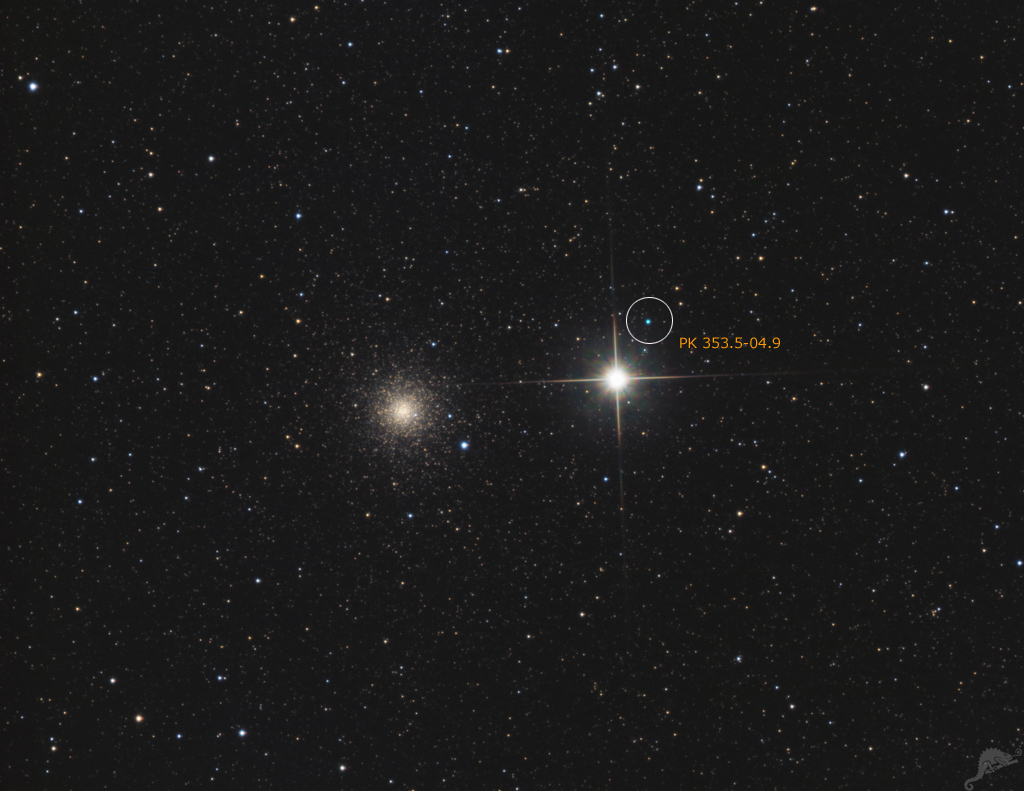|
| |
|
|
NGC 6441 and the small planetary nebula PK
353.5-04.9
|

|
This image
is a test of the new QHY 163M camera with short exposure times of 1 second. The
globular cluster NGC 6441 was photographed in 2016 with the EOS 6D at the
CDK12. The seeing conditions in the 2016 night were rather bad. In comparison
to this, the short 1 s exposures could achieve a significant increase in image
resolution. The seeing (FWHM) in the summed images of the color channels is
2.2'' (blue), 1.8'' (green) and 1.6'' (red). These are values that we had never
measured with longer exposure times at our location before. The luminance
channel was artificially generated from the red and green images due to the
good seeing values. The finished image is therefore an (RG)RGB image.
The Moon, 80 % illuminated, was only 20 degrees away from
NGC 6441 at the time of imaging, the limiting magnitude is about 17.3 mag
(v).
|
 |
 |
NGC
6441 (2017) Scale 1:1
Image data: 12.5" Planewave with Reducer ( f =
2.000mm)
Canon EOS 6D, 12 x 300 Seconds
|
NGC
6441 (2018) Scale 1:1
Image data: 12.5" Planewave without Reducer ( f =
2.540mm)
QHY 163M, Baader Filter R:G:B 1000:1000:1000 x 1
Seconds |
|
The direct
comparison clearly shows: despite the longer focal length of the Planewave
astrograph, the resolution of the many short exposures with the QHY 163M camera
is significantly higher than the summation of the 12 long exposures. The image
processing effort is significantly higher, but for bright objects it is worth
the time.
|
 |
Object description:
NGC 6441 was discovered on 13 May 1826 by the Scottish
astronomer James Dunlop, who described the object as "a small, well-defined,
rather bright nebula with a diameter of about 20 arc seconds".
The globular cluster NGC 6441 in the
constellation Scorpio is about 38,000 light years away from Earth. It is
located in the so-called galactic bulge (bulging part of the Milky Way around
the galactic center), "behind" the galactic center. Due to the interstellar
extinction, the light of the cluster is clearly reddened (E(B-V) = 0.47 mag)
and it appears to us in a yellowish tone.
It is one of the most luminous globular clusters of the Milky Way
with a mass of about 1.6 million solar masses. Spectroscopic investigations
have shown that many stars in the center of the cluster |
|
are
"metal-rich", that means an accumulation of heavier elements than helium. NGC
6441 contains a large number of RR lyrae variables, as well as at least 4
milliseconds of pulsars and one of the very rare planetary nebulae in globular
clusters.
Together with the 3.2 mag bright star G Scorpii, the star
cluster forms a pretty pair in the middle of the galactic sea of stars. G
Scorpii is an orange K-giant star with 16 times the size of our Sun and is
located in a distance of approx. 126 light years from the Sun. The small green
nebula directly northwest of G Scorpii is the planetary nebula PK 353.5-04.9.
The diameter is less than 10 arcseconds..
The above image shows a size
comparison to the full Moon and the location of the planetary nebula PK
353.5-04.9.
Click here or on the preview image to load a larger
version. |
| |
|
|
|












